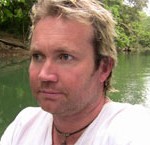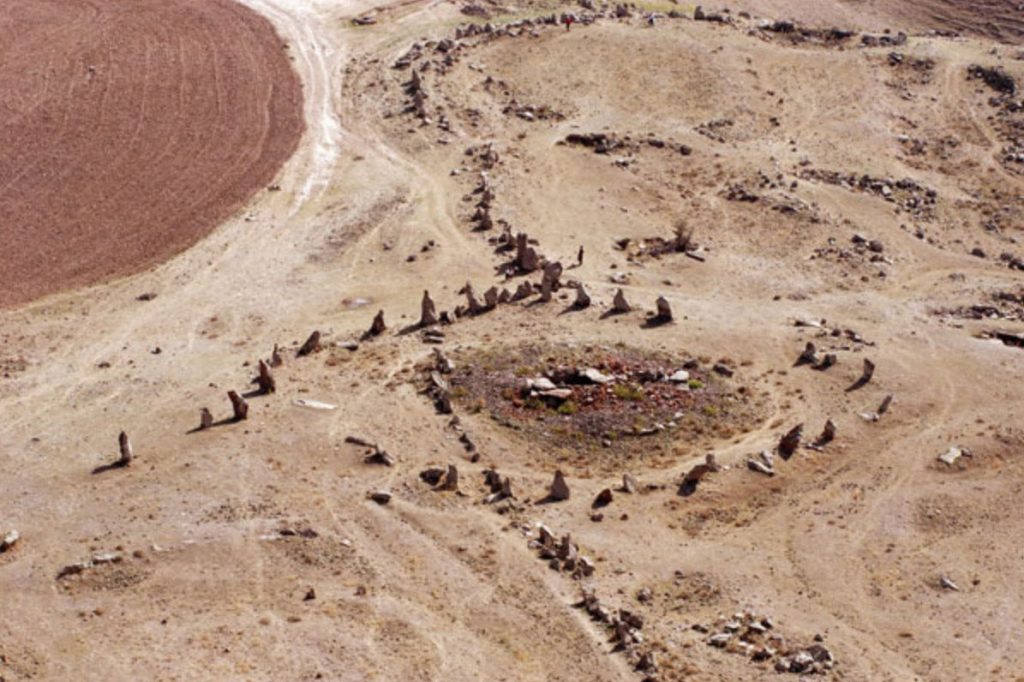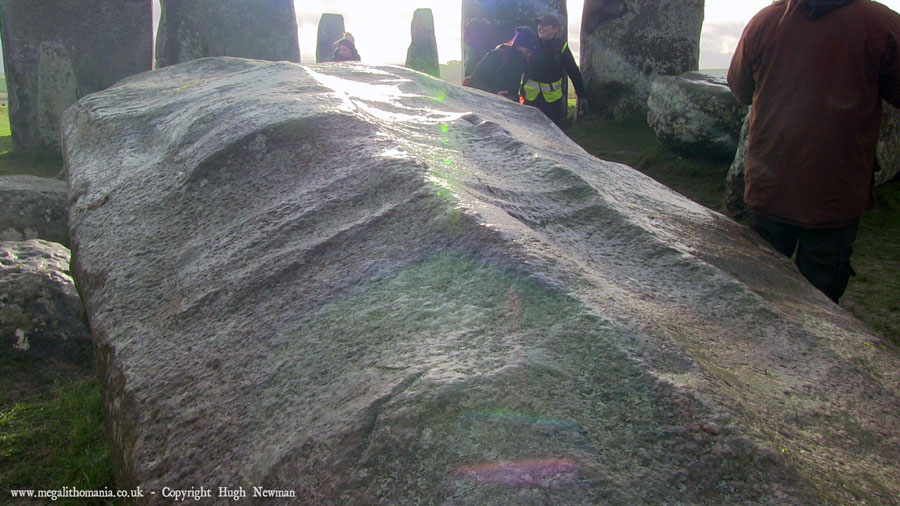It is with pleasure that we welcome Hugh Newman, contributor to Megalith: Studies In Stone as our Author of the Month for August.
Hugh discovers some of the world’s oldest examples of stone circles in remote and unlikely places, as well as seemingly shared ancient building techniques and traditions from around the world.
Stone circles conjure up a lost world of mysterious ceremonies, druid astronomers, pagan dances and inquisitive antiquarians. The most famous is Stonehenge in Wiltshire, UK, but it is also the most unusual in that it has lintels and trilithons in its design. Most stone circles are not so glamorous, but given that over one thousand of them dated to between 3500 BC and 1500 BC have been found in the British Isles alone, their construction was evidently an important part of our ancient culture. Stonehenge is also known for its summer solstice sunrise, and research over the last 60 years has shown that many other circles not only use sky and landscape alignments to mark astronomical events, but also share geometrical forms and measurement systems. Whoever made these magnificent structures had a deep understanding of engineering, surveying, geometry, metrology, acoustics and astronomy. And they were not an isolated group of builders—as we will see, stone circle building was once a global endeavour.
Gobekli Tepe: Stone Circle Genesis
6,500 years before Stonehenge was constructed, a vast megalithic complex was flourishing near present day Şanliurfa, southeast Turkey. Göbekli Tepe is at least 12,000 years old and its preserved stone circles are the oldest in the world. The ones so far uncovered exhibit impressive degrees of technical and artistic skill. Like Stonehenge, the monoliths were erected in circular arrangements, and oriented to particular areas of the sky. The world’s first stone circle complex is rewriting history books.
Göbekli Tepe consists of T-shaped pillars up to 20 ft. tall, many decorated with animal reliefs (scorpions, boars, lions, etc) and abstract human forms wearing belts inscribed with enigmatic ‘H’ and ‘U’ shapes. The taller stones rest in shallow nests on bedrock with small supportive dry-stone walls built in between them. In some enclosures, two central pillars orient towards a holed stone, the largest and oldest of which is 65ft wide. An enormous 24 ft.-long limestone pillar still sits in the nearby quarry. Over some 3,000 years the circles were filled in with rubble to create mounds, and other circular and oval enclosures built on top. Then, at around 8000 BC, the entire complex was carefully reconstructed and covered up. Interestingly, the oldest rings are not only the largest, but also the most sophisticated.
Like later sites around the world, astronomical alignments are evident. Figures depicted on the Vulture Stone may be the earliest representations of zodiacal and other constellations (including Cygnus). Our earliest surviving buildings therefore seem to be an early observatory built to track precession, the 25,800-year cycle of the pole stars.
Acoustics and Ellipses
It has been noted that the enclosures at Göbekli Tepe are roughly 4 to 3 ratio ellipses. Early stone ellipses seem to have been constructed using Pythagorean triangles and at least 30 examples have been recorded in Britain including Forvie Sands in Aberdeenshire, Postbridge in Devon, and Daviot in the Highlands of Scotland. The great megalithic ring and mound of Msoura in Morocco is also an ellipse that we will discuss shortly. The 4/3 ratio is the harmonic fourth, one of the great harmonies of acoustics. In his book The Cygnus Key, Andrew Collins suggests the enclosures were designed with this in mind.i
British Stone Circle in Morocco
In Morocco, a remote ring called Msoura sits near Asilah near the northwest coast. Located about 18 miles from the Phoneician ruins of Lixus, it is a huge ellipse of 168 surviving stones of an original 175, the tallest of which is 17ft (5m). Its major axis is 195ft (59.29m) wide by 185ft (56.18m). A massive, part-excavated tumulus was a later addition that sits in its centre. It encodes similar geometry and metrology to many British stone circles.
Msoura, incredibly, appears to have been constructed either by the same culture that erected the megalithic sites in France, Britain and Ireland or by one that was intimately connected with them.ii
Cup-Marks
Unusual cup-marks on the bedrock and on top of some of the oldest pillars at Göbekli Tepe prefigure British cup-marks by thousands of years. This is a tradition that is found throughout the Fertile Crescent, all over the British Isles and in Atlantic Europe. I recently investigated two American examples, both of which are petroglyph sites in Nevada; the 7,000 BC Grimes Point site and the 12,800 BC Winnemucca site. These are called cupules, which are concave depressions in the rock. Their presence at Göbekli Tepe has triggered many questions, not only as to what their purpose was, but how they relate to those found all over the world.
In 1970, Alexander Thom suggested in a BBC documentary, ‘Cracking the Stone Age Code’:
…that the cup and ring markings were a method of recording, of writing, and that they may indicate, once we can read them, what a particular stone was for. We have seen the cup and ring markings on the stone at Temple Wood, and that’s on the main stone but we can’t interpret them …yet.iii
He created diagrams and carried out an analysis of over 50 of the cup and ring markings from which he determined a length he termed the Megalithic Inch (MI).iv David Cowan, author of Ancient Energies of the Earth, believes they were created to manipulate natural telluric currents, to enhance fertility and link one cup-mark site up with another.v Whatever their purpose, the cup and ring markings are one of the many mysteries of stone circles.
Stone Circles of the Bible
The submerged site of Atlit Yam near Haifa in Israel dates to between 6900 and 6300 BC and is the earliest known evidence for an agro-pastoral-marine subsistence system on the Levantine coast. A stone semicircle containing seven half-ton monoliths was discovered at 8m-12m deep. The stones have cup marks carved into them and surround a freshwater spring. There is even a potential orientation to the Summer Solstice, and possible alignments to other stars, but these are yet to be fully researched due to their location underwater.
Further inland, dating to between 3000 and 4000 BC, is Rujm el-Hiri–(also known as Gilgal Refaim)–a huge series of concentric circles in the Golan Heights of Israel. It again has an opening in the outer circle that aligns to the Summer Solstice, as well as a burial chamber in the centre with many dolmens in the immediate area. Once again, the tradition of cup-marks is present at the site. The cup-mark phenomenon continues throughout Europe, some famous examples of which are at Clava Cairns, a bronze-age site in Southern Scotland.
In the Hebrew Bible, there are 39 mentions of Gilgal, a ‘circle of standing stones’. In one account, having miraculously crossed the river Jordan, Joshua orders the Israelites to take twelve large stones from the river bed, one for each tribe, and place them at Gilgal ‘in memory’. Gilgal has been identified with the village of Jiljilia, about 8m north of Bethel.
Armenian Stonehenge
Armenia is the unlikely location of one of the oldest and most impressive circles. Called Zorats Karer or Karenish by local people, and widely known as Armenia’s Stonehenge, Karahunge has 223 standing stones that vary between 2ft and 9ft tall and weigh up to 10 tons. Although no cup-marks have been found, eighty stones have circular holes drilled through them, 37 of which are still standing. Its name translates as ‘speaking stones’ and researchers have noted that the holes create sound when the wind is strong. 17 of the stones align to sunrise or sunset at the solstices and equinoxes, and 14 to lunar extremes. Russian prehistorian Professor Paris Herouni, using telescopic methods and the rules of precession, analysed a prominent holed stone oriented north that aligns with Deneb, the brightest star of Cygnus, in c. 5,500 BC.
Early Circles in Portugal
Near Evora is the 8,000-year-old Cromeleque dos Almendres with its rounded granite stones and nearby dolmens. From this 92-stone circle the midwinter sun rises above the 8ft Menhir do Almendres, 1km to the southeast. Again, some of the stones have cup-marks on them. The site was built in several phases beginning in c. 6000 BC and continuing up to c. 4000 BC.
South American Circles
The ‘Stonehenge of the Amazon’ is located on a hilltop near Calçoene, Amapa, Brazil. Here, 127 blocks of granite, up to 11 ft tall, are spaced at regular intervals around the hill, like a crown. The 100 ft circle is thought to have been constructed by the Amapán people between the 1st and 10th century AD. It has a winter solstice sunrise alignment.
Sillustani, near Lake Titicaca in Peru, is well known for its huge hilltop funerary towers called ‘Chulpas’. On the plains below are several astronomically-aligned stone circles built by the Kolla (a pre-Inca culture) between 100 AD and 1600 AD. The largest, at 34 ft, is Intiwatana which translates as “to moor the sun”, and traditions in the area say that these were astronomical circles. Once again, cup-marks have been found here, as well as spiral patterns in the rocks. However, the huge cupules seem to be mortice and tenon joints that linked the stones together, although ‘bosses’ or ‘protrusions’ are a tradition that is found all over Peru, including at Machu Picchu and Cusco. In fact, cultures such as the ancient Egyptians also had ‘protrusions’ like this on some of their megalithic structures and pyramids.
Return to Stonehenge
Further anomalies connect ancient Peruvian sites with Stonehenge. Two monoliths–one of the massive upright sarsens in the main Stonehenge circle and another fallen one–fashion a particular type of ‘scoop’ mark, as though the stone has been softened and an ice cream scoop has taken some of the stone away. Finally, on the eastern face of the same upright sarsen, a ‘protrusion’ that is badly weathered is of a similar style to those of South America! Coincidence? Possibly. But it would not surprise me if we are looking at ancient cultures that were connected at some point in prehistory.
Coming Full Circle
It goes without saying that these direct similarities between ancient stone circle sites are worthy of further investigation. With so few of them left to study and so few written records of them, it is only the big unmovable stones and the way they have been placed in relation to their respective landscapes that could hold the key to understanding our prehistoric ancestors.
The power of the ancients has come full circle. The prehistoric stone circles represent a golden age of astronomy, mystery and technological prowess, and with the current wave of Megalithomania sweeping the planet, no doubt more will be built, leaving archaeologists and antiquarians of the future as baffled as we are now!
References
i Andrew Collins, The Cygnus Key: The Denisovan Legacy, Gobekli Tepe, and the Birth of Egypt. Bear & Co. 2018. p. 195
ii Robert Temple, Egyptian Dawn, Century 2010. p. 379
iii The Spectator, p. 608. 1970.
iv Systematics: The Journal of the Institute for the comparative study of History, Philosophy and the Sciences, Vol. 6, Number 3, Coombe Spring Press., December 1968
v David Cowan, Ancient Energies of the Earth: An Extraordinary Journey into the Earth’s Natural Energy System, Thorsons, 1999.
About the author
Hugh Newman is a world explorer, megalithomaniac and author of Earth Grids: The Secret Pattern of Gaia’s Sacred Sites (2008); co-author of Giants On Record: America’s Hidden History, Secrets in the Mounds and the Smithsonian Files with Jim Vieira (2015); co-author of Stone Circles (2017), and contributor to Megalith: Studies In Stone (2018). He has been published in three ‘Ancient Origins’ e-books. He has appeared on the BBC, Sky TV and Bosnian TV, and is currently involved in documentary projects Megalithic Odyssey (UK), Road 2 Ruins (US) and Ancient Tomorrow (US). He is a video producer who publishes films of his worldwide explorations regularly, on YouTube. He has articles published in Atlantis Rising (US), New Dawn (Australia), Nexus (UK/AUS), Mindscape (UK), Heretic (UK), World Explorers Magazine (US), The Circular (UK), The Leyhunter (UK), and websites Ancient Origins and Graham Hancock. As well as organising the annual Megalithomania conferences and tours, he co-organises the Origins Conference in London with Andrew Collins and has spoken at events in the UK, Malta, France, Peru, Egypt, Bosnia, Cambodia, Java and North America. He currently lives in Wiltshire, England.




















Hi,
“The cup-mark phenomenon continues throughout Europe, some famous examples of which are at Clava Cairns, a bronze-age site in Southern Scotland.”
Actually to the east of Inverness in the Highlands of Scotland.
Regards Lyndon
Thanks interesting article but,
“The cup-mark phenomenon continues throughout Europe, some famous examples of which are at Clava Cairns, a bronze-age site in Southern Scotland.”
The Clava Cairns are just to the east of Inverness, in the highlands of Scotland.
Regards Lyndon
Apologies. I’ll ask the webmaster to correct that!
Has there been any progress in translating the hole and rings carved in megalithic structures from seems like all over the globe? Love your work! Keep it up! It does matter and people are listening!
https://www.youtube.com/watch?v=UKDzZo9lOus
The system Thom discovered is definitely the imperial x 34/33
cheers
DaveK
Hi! Fascinating read, thank you. I recently went to this location in North East Holland, where there are also Megalithic stones bearing the Cup Marks: http://www.hunebedden.nl/d16eng.htm No stone naturally occurs in the Dutch landscape, these were all deposited by glacier.
u need to check out the story of stone circle near Mullumbimby NSW Australia. Apparently dozed by the land owner but drawings survive.
http://forgottenorigin.com/1-australias-stonehenge-the-history-of-an-ancient-stone-arrangement-40-kilometres-from-mullumbimby-nsw
http://forgottenorigin.com/1-australias-stonehenge-the-history-of-an-ancient-stone-arrangement-40-kilometres-from-mullumbimby-nsw
check this out mate.
If you want to know the whole story l will tell you.Sadly you won’t believe me.l will you tell that the pyramids are the master plan.
I would like to know how the author dated any of these circles, given that stone cannot be dated. He does not mention any firmly proven organic linkage, such as those found in the burial material of Gobleki Tepi for example, which at least date when it was buried. Also, I do not see a reference to the “oldest”, and most mysterious of them all, at Nabta Playa.